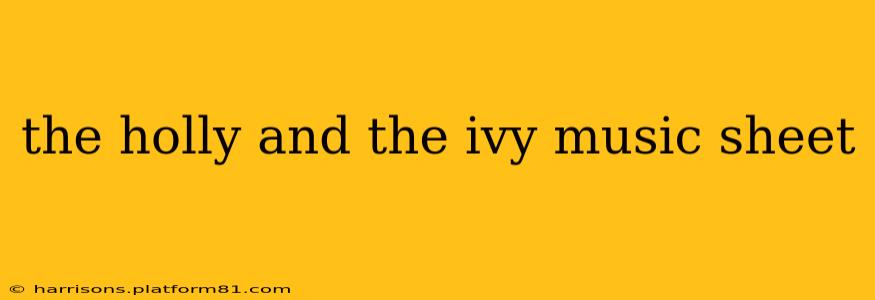The carol "The Holly and the Ivy" is a timeless classic, its haunting melody and evocative lyrics resonating with audiences for centuries. While its precise origins remain shrouded in mystery, its enduring popularity speaks to its powerful message and enduring musical appeal. This post will delve into the history of "The Holly and the Ivy," explore different versions of the music sheet, and answer some frequently asked questions surrounding this beloved Christmas carol.
What is the history of "The Holly and the Ivy"?
The earliest known version of "The Holly and the Ivy" dates back to the 16th century, appearing in a manuscript titled The Mulliner Book. However, its origins likely predate this, possibly stretching back to even earlier medieval traditions. The lyrics allude to ancient symbolism, associating the holly with Christ's crown of thorns and the ivy with his evergreen nature, signifying eternal life. This connection to religious symbolism solidified its place within the Christmas tradition. The carol's popularity fluctuated over the centuries, enjoying periods of widespread use and then fading into relative obscurity before experiencing a resurgence in modern times.
Where can I find the music sheet for "The Holly and the Ivy"?
Numerous sources offer music sheets for "The Holly and the Ivy." Many websites dedicated to Christmas carols and traditional music provide free downloads or printable versions. You can also find arrangements for various instruments and vocal ranges. Additionally, numerous published collections of Christmas carols include this classic piece. A simple online search for "The Holly and the Ivy sheet music" should yield many results. Remember to check licensing before using any sheet music for commercial purposes.
What are the different versions of "The Holly and the Ivy"?
While the core melody and lyrics remain relatively consistent, subtle variations exist across different versions of "The Holly and the Ivy." These variations often pertain to the melody's ornamentation, the arrangement (e.g., for solo voice, choir, or instrumental ensemble), and occasionally minor lyrical differences. Some versions might emphasize certain aspects of the lyrics, while others feature a more straightforward rendering. These differences contribute to the rich tapestry of interpretations that have evolved around this enduring carol.
Is "The Holly and the Ivy" a traditional Christmas carol?
Yes, "The Holly and the Ivy" is widely considered a traditional Christmas carol. Its age, association with Christmas themes, and enduring popularity cement its place within the broader Christmas carol tradition. Though its exact origins are uncertain, its symbolic lyrics and melodic appeal have resonated with generations, contributing to its status as a cherished seasonal classic.
What is the meaning of the lyrics in "The Holly and the Ivy"?
The lyrics of "The Holly and the Ivy" use the holly and the ivy as metaphors. The holly, with its prickly leaves and bright red berries, symbolizes the crown of thorns worn by Jesus. The ivy, an evergreen vine, represents Christ’s everlasting life. The carol compares the virtues of the holly and ivy, ultimately suggesting the superiority of the ivy, symbolizing the triumph of Christ’s eternal life over the temporary suffering represented by the holly. This deep symbolic meaning adds layers of richness and significance to the carol's already captivating melody.
Who wrote "The Holly and the Ivy"?
The composer of "The Holly and the Ivy" is unknown. The carol’s anonymous origins add to its mystique and contribute to its status as a truly traditional piece of music. It's a testament to the carol's power that its authorship remains a mystery, yet its beauty and impact continue to endure through the centuries. The focus shifts from the creator to the song itself, highlighting its universal appeal and timeless message.
This exploration hopefully provides a more comprehensive understanding of "The Holly and the Ivy," its rich history, and its lasting place in the Christmas music tradition. The song's enduring appeal lies not only in its catchy melody but also in the powerful symbolism woven into its lyrics, offering a reflection on faith, life, and the enduring spirit of Christmas.
